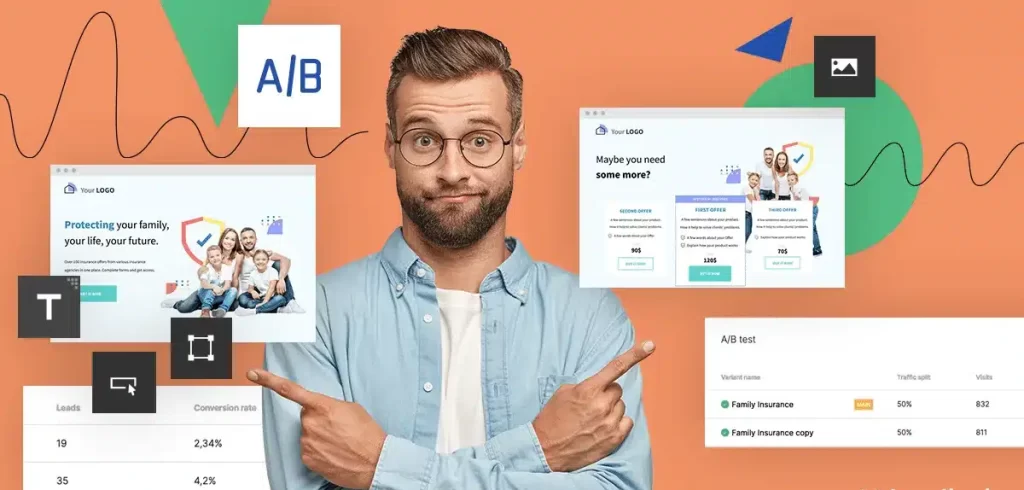The landscape of eCommerce is ever-evolving, and in this dynamic ecosystem, the ability to adapt and optimize is paramount. A/B testing offers a strategic approach to fine-tuning your online presence, but its true power lies in the data-driven insights it provides. By harnessing the nuances of user behavior and preferences, companies can unlock a treasure trove of information that can significantly impact their bottom line. In a world where every click matters, understanding how to leverage A/B testing for data-driven design could be the game-changer your eCommerce business needs.
Introduction to A/B Testing for eCommerce Companies
A/B testing is a method used by eCommerce companies to compare two versions of a webpage or app to determine which one performs better. This process allows businesses to make data-driven decisions on changes that can improve user experience and ultimately increase sales. Understanding the importance and benefits of A/B testing is crucial for eCommerce companies looking to optimize their online presence and drive revenue growth.
What is A/B Testing?
When optimizing their online platforms, eCommerce companies often employ a method known as split testing to enhance user experience and drive sales. A/B testing, a form of split testing, involves comparing two versions of a webpage or app to see which performs better. For eCommerce companies, this data-driven approach is integral to refining their eCommerce strategy, as it allows them to make informed decisions based on real user interactions.
The benefits of A/B testing for eCommerce companies include increased conversion rates, improved customer engagement, and higher revenue. To execute successful A/B tests, eCommerce companies can utilize various tools and platforms tailored for this purpose. Leveraging the best A/B testing resources and eCommerce development services is crucial for implementing effective testing strategies that lead to enhanced online performance.
Why eCommerce Companies Need A/B Testing
Ecommerce companies rely on A/B testing as a fundamental tool for optimizing their online platforms and driving business growth through data-driven decision-making. By conducting controlled experiments that compare two versions of a webpage or app to determine which performs better, companies can make informed changes that positively impact their conversion rates and overall sales. A/B testing allows businesses to understand customer behavior, preferences, and trends, enabling them to tailor their strategies for maximum effectiveness. Hiring an ecommerce consultant with expertise in A/B testing can further enhance a company’s testing capabilities and help identify areas for improvement. Below is a table highlighting key reasons why A/B testing is essential for ecommerce success:
| Key Reasons for A/B Testing in Ecommerce |
|---|
| Improves conversion rates |
| Enhances user experience |
| Boosts sales and revenue |
| Informs data-driven decision-making |
| Identifies areas for optimization |

Essential Elements of an Effective A/B Test
To conduct an effective A/B test, it is crucial to define clear objectives that outline what you aim to achieve with the test. Identifying key metrics for success is essential as these will be used to measure the impact of the variations being tested. These elements serve as the foundation for a structured and informative A/B testing process that can lead to significant improvements in ecommerce sales.
Defining Clear Objectives
Establishing precise and measurable goals is a critical step in creating a successful A/B test for determining the impact on ecommerce sales. When defining objectives for A/B testing:
- Be Specific: Clearly outline what you aim to achieve through the test.
- Set Measurable Metrics: Define how success will be quantified to gauge the effectiveness of each variant.
- Focus on Key Performance Indicators (KPIs): Align objectives with important metrics like conversion rates, click-through rates, or average order value.
- Consider User Experience: Ensure that objectives account for enhancing the overall user experience to drive higher sales.
Identifying Key Metrics for Success
Understanding the role of conversion rates in A/B testing is crucial for optimizing ecommerce sales. Equally important are the metrics related to customer retention, as they directly impact long-term profitability. By focusing on these key metrics, businesses can effectively evaluate the success of their A/B tests and make data-driven decisions to boost sales.
The Role of Conversion Rates in A/B Testing
Conversion rates play a pivotal role in A/B testing, serving as the cornerstone for evaluating the effectiveness of various strategies in boosting ecommerce sales.
- 1. Measure the percentage of visitors who make a purchase.
- 2. Compare conversion rates between control and variant groups.
- 3. Determine which design or content changes lead to higher conversion rates.
- 4. Optimize strategies based on conversion rate results.
Importance of Customer Retention Metrics
To further enhance the effectiveness of A/B testing in boosting ecommerce sales, it is imperative to consider the impact of customer retention metrics on the overall success of the testing process. Understanding metrics such as repeat purchase rate, customer lifetime value, churn rate, average order value, and customer satisfaction levels is crucial in implementing strategies that foster long-term customer relationships and drive sustainable revenue growth.
| Customer Retention Metrics | Definition | Importance |
|---|---|---|
| Repeat Purchase Rate | Percentage of customers making repeat purchases | Indicates loyalty and satisfaction |
| Customer Lifetime Value | Total revenue a business can expect from a customer | Guides marketing and retention efforts |
| Churn Rate | Rate at which customers stop doing business with a company | Highlights retention challenges and areas for improvement |
| Average Order Value | Average amount spent by customers per transaction | Influences revenue generation and marketing strategies |
| Customer Satisfaction Levels | Measurement of how satisfied customers are with a company’s products or services | Reflects brand loyalty and likelihood of repeat business |
Setting Up Your First A/B Test
When setting up your first A/B test, choosing the right tools and resources is essential for ensuring accurate and reliable results. The tools you select should align with your objectives and make it easy to implement and track the test variations. By investing time in selecting the right tools upfront, you can set a strong foundation for successful A/B testing in your ecommerce strategy.
Choosing the Right Tools and Resources
To set up your first A/B test, selecting the appropriate tools and resources is crucial. Beginners can benefit from utilizing user-friendly A/B testing platforms like Google Optimize or Optimizely. These tools offer intuitive interfaces and step-by-step guidance to streamline the testing process for improved ecommerce sales.
Best A/B Testing Resources for Beginners
For beginners venturing into A/B testing, selecting the most suitable tools and resources is crucial for ensuring accurate and insightful results. Here are some of the best resources to kickstart your A/B testing journey:
- Google Optimize: User-friendly tool by Google.
- Optimizely: Offers robust features and integrations.
- VWO: Provides a comprehensive platform for testing.
- AB Tasty: Great for beginners with simple yet effective features.
Developing an eCommerce Strategy with A/B Testing
Integrating A/B testing into long-term strategies allows eCommerce businesses to make data-driven decisions that align with their overall objectives. By continuously testing and optimizing various elements, such as website design, product placement, and marketing strategies, companies can adapt to the ever-changing market demands. This systematic approach enables organizations to stay agile and competitive in the online retail landscape.
Integrating A/B Testing into Long-term Strategies
Integrating A/B testing into long-term strategies involves aligning testing efforts with overarching business goals to ensure meaningful results. By developing an eCommerce strategy with A/B testing at its core, companies can systematically test different elements to optimize their online presence. This strategic approach enables organizations to make data-driven decisions that drive continuous improvement and sustainable growth.
Aligning A/B Testing with Business Goals
Aligning A/B testing with business goals requires a strategic approach that intertwines data-driven experimentation with overarching organizational objectives. To effectively align A/B testing with business goals, consider the following:
- Define clear business objectives.
- Identify key performance indicators (KPIs).
- Create hypotheses based on business goals.
- Measure and track results to assess alignment with objectives.

Common Mistakes to Avoid in A/B Testing
When conducting A/B testing for boosting ecommerce sales, it is crucial to avoid common mistakes that can skew results. Overlooking statistical significance and testing too many variables simultaneously are frequent errors that can undermine the validity of the testing process. By being mindful of these pitfalls, businesses can ensure that their A/B testing efforts lead to actionable insights and improved sales performance.
Overlooking Statistical Significance
In the realm of A/B testing for boosting ecommerce sales, one crucial mistake to avoid is overlooking statistical significance. When conducting A/B tests, failing to pay attention to statistical significance can lead to inaccurate conclusions and poor decision-making. To ensure the reliability of your test results, consider the following key points:
- Sample Size: Ensure that your sample size is large enough to detect meaningful differences.
- Confidence Level: Choose an appropriate confidence level to determine the reliability of your results.
- Statistical Tools: Use reliable statistical tools to analyze and interpret your data accurately.
- Significance Threshold: Establish a significance threshold to determine when results are statistically significant.
Testing Too Many Variables at Once
Attempting to test too many variables simultaneously in an A/B test can introduce unnecessary complexity and obscure the true impact of individual changes on ecommerce sales. By overwhelming the experiment with numerous variables, it becomes challenging to pinpoint which specific change positively or negatively influenced the results. To ensure clear and actionable insights, it is advisable to focus on testing one or two variables at a time. This approach allows for a more precise understanding of the impact of each change on key metrics such as conversion rates and sales. By methodically testing one variable after another, businesses can make informed decisions based on reliable data analysis.
| Variable | Description | Impact on Sales |
|---|---|---|
| A | Color of Call-to-Action | Increase |
| B | Placement of Product Image | Decrease |
| C | Font Style of Headings | No Impact |
How to Analyze A/B Testing Results
Analyzing A/B testing results involves understanding data patterns and trends to draw meaningful conclusions. By identifying statistical significance and conversion rate variations between the control and experimental groups, one can determine the effectiveness of the changes made. This analysis is crucial for making informed decisions to optimize strategies and enhance ecommerce sales.
Understanding Data Patterns and Trends
To effectively analyze A/B testing results, it is crucial to utilize advanced analytical tools that can provide detailed insights into data patterns and trends. These tools help in identifying significant variations between different test groups and determining the impact of changes on key performance metrics. By leveraging these analytical capabilities, businesses can make informed decisions to optimize their strategies and boost ecommerce sales.
Utilizing Advanced Analytical Tools
Effectively understanding data patterns and trends is crucial when analyzing A/B testing results using advanced analytical tools in ecommerce.
- 1. Utilize segmentation to identify specific user behavior.
- 2. Implement cohort analysis to track user groups over time.
- 3. Employ funnel analysis to optimize the conversion process.
- 4. Use heatmaps and session recordings to visualize user interactions.
Role of eCommerce Development Services in A/B Testing
In the realm of A/B testing, eCommerce development services play a pivotal role in enhancing the effectiveness of tests conducted. These professionals bring a wealth of technical expertise and experience to the table, ensuring that the testing process is optimized for accurate results and actionable insights. By leveraging their skills, businesses can make informed decisions that drive significant improvements in their online sales performance.
How Professionals Can Enhance Test Effectiveness
One vital aspect of enhancing test effectiveness for professionals in A/B testing lies in leveraging the expertise of eCommerce development services. These services play a crucial role in optimizing the testing process and ultimately driving higher conversion rates. To enhance test effectiveness, professionals can collaborate with eCommerce development services to:
- Implement Advanced Tracking: Utilize advanced tracking tools to monitor user behavior accurately.
- Customize Testing Tools: Tailor A/B testing tools to fit the specific needs of the eCommerce platform.
- Integrate Data Analysis: Incorporate robust data analysis capabilities to derive actionable insights from test results.
- Ensure Seamless Integration: Guarantee smooth integration of A/B testing processes with the overall eCommerce infrastructure for optimal performance.
Consulting an eCommerce Consultant for Advanced Testing
When it comes to advancing your A/B testing strategies, consulting an eCommerce consultant can be invaluable. These experts can provide insights on when to bring in specialized help, ensuring that your testing methods are optimized for maximum impact. By leveraging the expertise of an eCommerce consultant, you can navigate complex testing scenarios with confidence and precision.
When to Bring in Expert Help
For businesses looking to maximize their ecommerce sales through A/B testing, consulting an eCommerce consultant for advanced testing can provide invaluable insights and expertise. These professionals bring a wealth of experience in analyzing data, interpreting results, and implementing effective strategies to enhance conversions. Their guidance can lead to more targeted experiments, quicker optimization, and ultimately, increased revenue for online stores.
Benefits of Professional Guidance in A/B Testing
Seeking professional guidance in A/B testing can significantly enhance the effectiveness of ecommerce strategies and optimize sales performance. When considering expert help, remember:
- Specialized Knowledge: Consultants bring in-depth expertise.
- Advanced Tools: Access to cutting-edge testing tools.
- Data Interpretation: Assistance in analyzing complex data sets.
- Strategic Insights: Guidance for implementing successful A/B test variations.
Comprehensive Software Development Solutions
Unlock the potential of digital transformation with our bespoke software development services, engineered to foster innovation, maximize efficiency, and catalyze business growth.

Conclusion
In conclusion, A/B testing is a powerful tool for eCommerce companies to optimize their website design and increase sales. By using data-driven design principles, companies can make informed decisions that lead to improved user experience and higher conversion rates. It is essential to carefully plan and analyze A/B tests, avoiding common mistakes to ensure accurate results. Consulting with eCommerce development services and experts can further enhance the effectiveness of A/B testing strategies.
Can A/B Testing Be Used for Non-Ecommerce Websites?
A/B testing can be invaluable for non-ecommerce websites as well. It allows for data-driven decision-making by comparing different versions of a webpage to determine which performs better. This method can optimize user experience, increase conversions, and enhance overall website effectiveness.
How Can A/B Testing Benefit Small Ecommerce Businesses With Limited Resources?
A/B testing offers small ecommerce businesses with limited resources the opportunity to optimize their website, improve user experience, and increase conversions by comparing different design elements and strategies to identify what resonates best with their audience.
What Are Some Creative Ways to Come up With Test Ideas for A/B Testing?
To generate creative A/B testing ideas, consider customer feedback, industry trends, competitor analysis, and data insights. Brainstorm hypotheses based on user behavior, pain points, and preferences. Utilize heatmaps, surveys, and user testing to uncover areas for optimization and experimentation.
How Can Ethical Considerations Be Incorporated Into A/B Testing Practices?
Ethical considerations in A/B testing involve ensuring transparency, obtaining informed consent, and safeguarding user data. Upholding privacy laws, respecting user preferences, and avoiding discriminatory practices are essential. A commitment to ethical principles enhances trust, credibility, and customer satisfaction.



